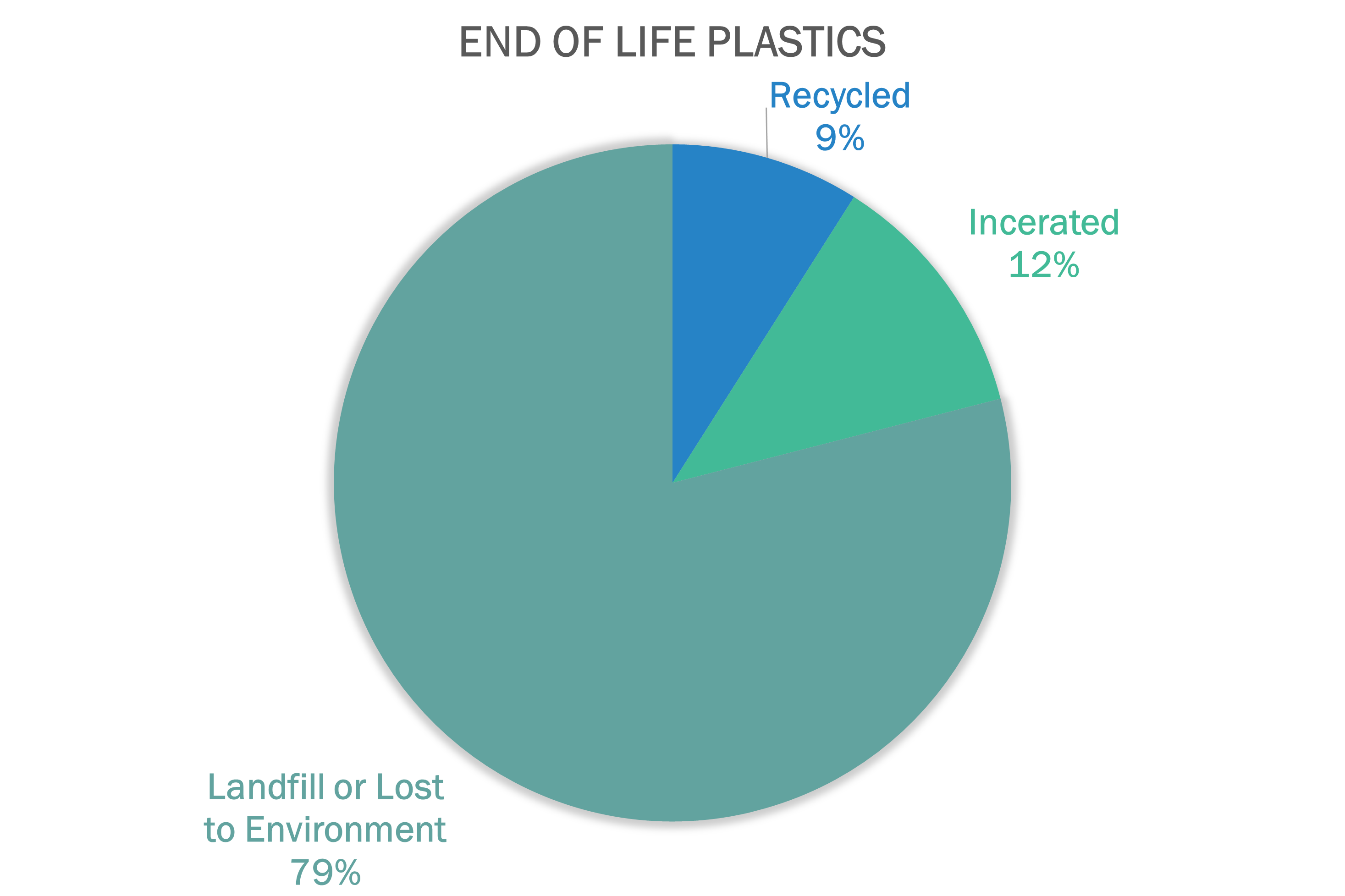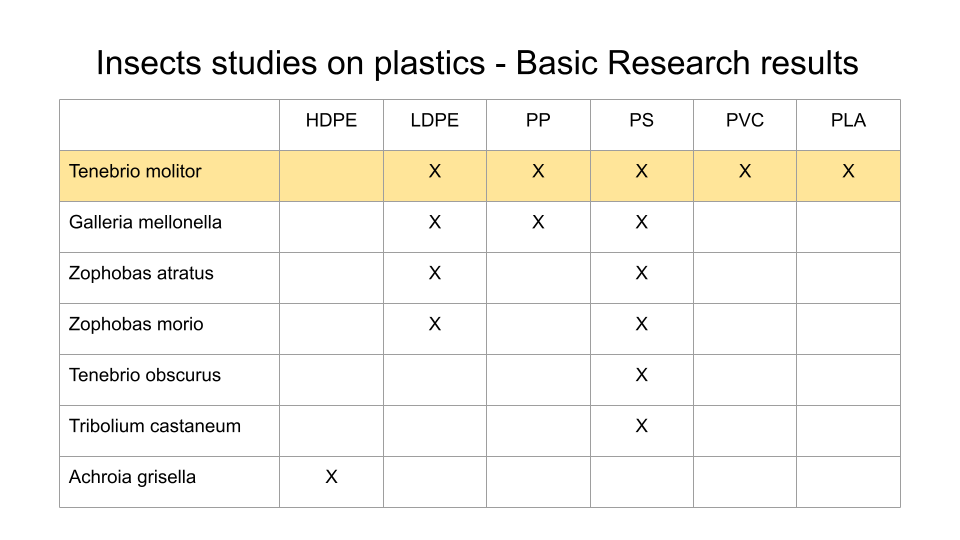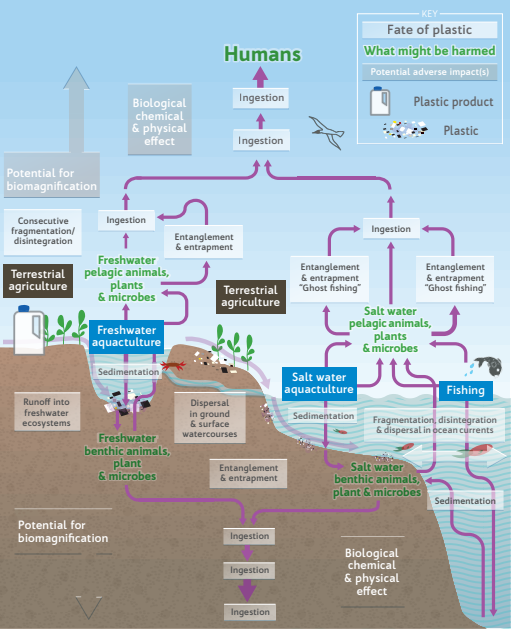Bugs Eat Plastic
It's amazing and true. Bugs can eat plastic. If you want to learn more about why that matters, which bugs eat what kinds of plastics, and more, read on. But first, please rest assured that no products that we sell have EVER been fed plastics. Any experiments we've run have been walled off from our main farm.
In 2020, 367 million metric tons of plastic were produced globally. Only 9% of all plastics ever produced have been recycled, 12% incinerated, with the remaining 79% landfilled or lost to the environment.

These two images depict the fate of plastic and how it ends up into our oceans, soils, and bodies. Plastics are widely used and are increasingly prevalent in our environment.
For every polystyrene (StyrofoamTM) cup, 32 grams of CO2 (or equivalent) is released into the atmosphere. The US produces over 3.5 million tons of polystyrene, leading to approximately 21 million tons of CO2 equivalent being released each year. That's the same as driving 4 million cars! It is unlikely polystyrene will naturally decompose as it needs perfect conditions to deconstruct, especially in an environmentally safe way. Polystyrene is estimated to take 500 years to naturally decompose. This presents a problem we want to address: The extensive accumulation of single use expanded polystyrene.
Potential Solutions
There are a number of different solutions to address plastic waste and contamination of the environment: chemical processing, legislation, burning, and biological. Normal recycling of plastic #1 and #2 can be successful, but most other plastics go to landfills. Not all the solutions are able to capture the entirety of the waste problem, and some have higher environmental costs than others.
We've landed on biological solutions to solve the problem.
Basic research has already shown multiple inspect species carry gut bacteria that can break down a variety of plastics:

HDPE = High density polyethylene PET = Polyethylene terephthalate PS = Polystyrene LDPE = Low density polyethylene PP = Polypropylene PVC = Polyvinyl chloride LLDPE = Linear low density polyethylene PLA = Polylactide
Recently, more studies are identifying new bacteria of interest that have yet to be explored. This demonstrates there are still novel bacteria within different regions of the insect digestive tract to be discovered and further analyzed. None or limited amounts of insect-derived bacteria have been tested for commercial viability.
What are we doing?
We want to put our money where our mouth is. Planet Bugs wants to demonstrate that we aren’t just talking about doing great things, but we are actively helping and achieving it when it comes to helping the planet.
We are pledging 1% of our revenue to the organization 1% for the Planet, which is specifically going to organizations aiming at reducing plastics through novel research & lobbying. We are supporting organizations coming to realistic solutions that don't involve switching to non-functional alternatives (e.g. annoying paper straws)
Right now it doesn’t economically work to be taking in EPS and breaking it down. Our mealworms are just a bit too slow and we aren’t competitive with landfills. We either need to be 1000 times faster than we are now, or we need to be getting paid significantly more to fully run a business breaking down plastic. This is why we are pledging another 4% of our revenue (5% total) towards academic and in-house research. A significant amount of work has already been done on breaking down plastics, by us and others, but much more research is needed for it to become commerically viable. We are starting to partner with universities to run a pilot study for 2024, focusing on growing novel bacteria and fungi on plastic to demonstrate scalable plastic breakdown.
Day 0

Day 10

Day 33

There's a bit of misinformation out there we'd like to address. Mealworms cannot live on EPS as their only food source. It does not provide sufficient calories or nutrition.
There have been some studies and articles (citation needed) claiming a small colony of mealworms have survived when fed only EPS. While true, this is misleading. They noticed a lower survival rate than the worms fed a traditional diet (e.g., wheat bran) and lower body weight. The two factors they did not consider were cannibalism (i.e., the survivors were eating the less fortunate) and longer term health and survival.



